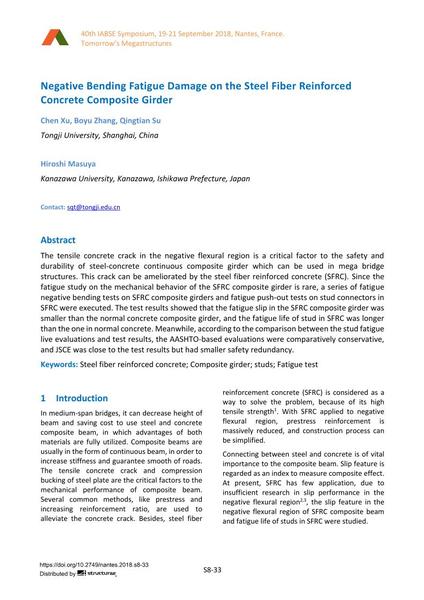Negative Bending Fatigue Damage on the Steel Fiber Reinforced Concrete Composite Girder

|
|
|||||||||||
Bibliografische Angaben
| Autor(en): |
Chen Xu
(Tongji University, Shanghai, China)
Boyu Zhang (Tongji University, Shanghai, China) Qingtian Su (Tongji University, Shanghai, China) Hiroshi Masuya (Kanazawa University, Kanazawa, Ishikawa Prefecture, Japan) |
||||
|---|---|---|---|---|---|
| Medium: | Tagungsbeitrag | ||||
| Sprache(n): | Englisch | ||||
| Tagung: | IABSE Symposium: Tomorrow’s Megastructures, Nantes, France, 19-21 September 2018 | ||||
| Veröffentlicht in: | IABSE Symposium Nantes 2018 | ||||
|
|||||
| Seite(n): | S8-33 | ||||
| Anzahl der Seiten (im PDF): | 7 | ||||
| DOI: | 10.2749/nantes.2018.s8-33 | ||||
| Abstrakt: |
The tensile concrete crack in the negative flexural region is a critical factor to the safety and durability of steel-concrete continuous composite girder which can be used in mega bridge structures. This crack can be ameliorated by the steel fiber reinforced concrete (SFRC). Since the fatigue study on the mechanical behavior of the SFRC composite girder is rare, a series of fatigue negative bending tests on SFRC composite girders and fatigue push-out tests on stud connectors in SFRC were executed. The test results showed that the fatigue slip in the SFRC composite girder was smaller than the normal concrete composite girder, and the fatigue life of stud in SFRC was longer than the one in normal concrete. Meanwhile, according to the comparison between the stud fatigue live evaluations and test results, the AASHTO-based evaluations were comparatively conservative, and JSCE was close to the test results but had smaller safety redundancy. |
||||
| Stichwörter: |
faserverstärkter Stahlfaserbeton
|
||||
